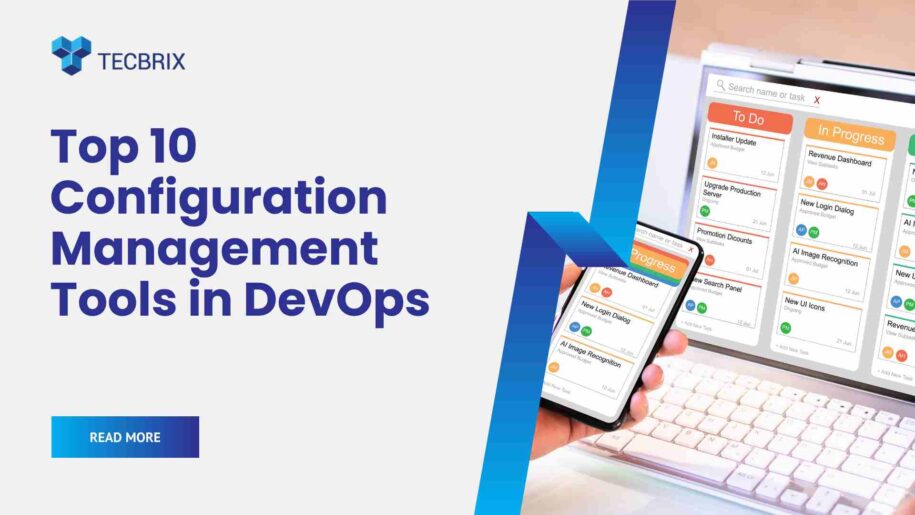Businesses that are busy scaling their product and service have to revamp and scale their entire IT infrastructure to meet the evolving challenges and market expectations. To meet this goal, they need configuration management tools to handle different key areas of their IT frameworks to sustain their operational and developmental needs.
These configuration management tools in DevOps are intended to assist development and operations teams in managing their IT infrastructure, underdevelopment applications, cloud services, and software or hardware resources.
Therefore, configuration management tools in DevOps cover every key area of IT ecosystems, which is why it’s vital to opt for the right utility. This blog post will shed light on some of the top configuration management tools in DevOps. Let’s discuss this in detail.
Top 10 Configuration Management Tools in DevOps
Below is the list of the top 10 and most renowned configuration management tools in DevOps.
1. Ansible
Fundamentally, the most widely used and leveraged utility for any company, Ansible, allows the developer to automate most of their repetitive tasks and focus on core and strategic development areas. Therefore, it spares the load of dealing with the routine and manual tasks that interfere with the complex workloads. The system offers executable XML and YAML file systems to define the system configuration framework. The defined hierarchy of directions is then implemented with the help of Python-based directives. The entire platform is very simple to adapt and master as it lacks any need for dedicated experts to manage nodes.
2. Terraform
An open-source supply chain management framework for easy-to-manage containers, services, or cloud-native frameworks using Infrastructure as a Cloud IaaC. The utility can be easily merged with Microsoft Azure, Amazon Web Services, and a bunch of different renowned cloud services.
It allows you to define repetitive deployments for cloud frameworks, with the platform assisting you to support the AWS framework using text files and dealing with the defined deployment workloads in a streamlined fashion.
3. Chef Infra
Centric around DevOps, tools offered by Chef help offer new opportunities in IT management. They fundamentally assist in speeding up the delivery of software via a fast-paced framework of developing, testing, and integrating new platforms, deploying the latest software updates easily, and enhancing system flexibility via integrated metrics. It’s a useful tool to properly deliver any sort of software or application in any ecosystem without any hassle.
4. Vagrant
Aims on the development and maintenance of VMs, Vagrant assists in reducing the time required to layout a development framework and scale up the production capacity. You can also leverage it to easily share VM configurations and define/share resources among different team members without getting into the nitty-gritty of complex functionalities.
5. TeamCity
TeamCity is another remarkable tool among the Configuration Management Tools in DevOps used for continuous integration/continuous development (CI/CD) using the famous JetBrains. This framework allows you to consume source code from different version control machines to call for the development of a unified system, recalling the settings from existing or parent projects to be used in child projects in a range of ways. It is a remarkable CI/CD platform to check builds via a user-friendly Project Dashboard and define workloads in different frameworks with more flexibility.
6. Puppet Enterprise
There are two variants offered by the developers of Puppet namely Puppet & Puppet Enterprise. The first version is an open-source and free version, and the enterprise version can be used unpaid for only ten nodes. It is a very organized utility that utilizes modules to keep track and control everything and helps in making instant modifications to match the customized requirements. Therefore, it allows you to orchestrate containers, monitor live updates, and define or execute deployments faster. It allows you to define IaaC and fulfill compulsory system configurations.
7. Octopus Deploy
This is another one of the top configuration management tools in DevOps that allows you to make complex deployments easy to manage both in on-promise frameworks and cloud infrastructures. The platforms offer all the utilities necessary to dodge many mainstream deployment errors, hassle-free distribution of SDLC workloads among your team members, effortlessly deploy in new and unseen frameworks and fundamentally compound your defined number of software releases within a particular time frame.
8. SaltStack
This Python-oriented configuration utility offers Secure Shell (SSH) and ensures methodologies for an impactful client-business collaboration. Just like implementing ad-hoc scripts, this framework offers a much more authentic and well-organized workflow with multiple features to streamline for seamless & continuous deployment and delivery practices.
9. AWS Config
Using AWS Config, you can easily evaluate and analyze configurations linked with AWS frameworks. It also offers some confidential tracking features to track the comprehensive history of configurations and set up broad-scale regulatory compliances for configurations.
10. Microsoft Endpoint Manager
MS Endpoint Manager assists in allowing robust security and scrutiny of endpoints, managing devices comprehensively, and acquiring a more flexible framework in cloud-native resource management. Ranging from mission-critical servers & VMs to desktop or smart devices – Microsoft’s Endpoint Manager can be utilized to monitor and control a variety of objects & frameworks. These frameworks can be based on-premises infrastructures of clouds. It allows you to create quick configuration modules, regulatory and application security policies, etc.
End Words
The primary use cases and perks of configuration management tools in DevOps are to implement, manage or control CI/CD workloads, Agile methodologies, and other IT configuration practices. They can help you streamline a range of repetitive tasks and dodge common pain points in the entire SDLC framework.
Configuration management tools in DevOps like Ansible & Terraform have a lot of potential especially when it comes to impactfully organizing and controlling SDLC workloads for their seamless fulfillment.

